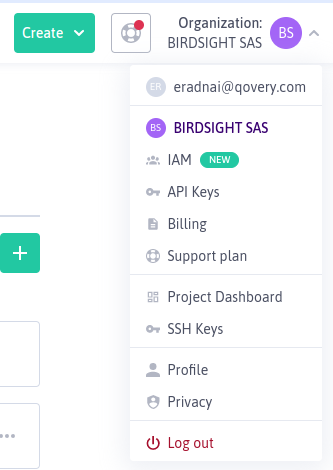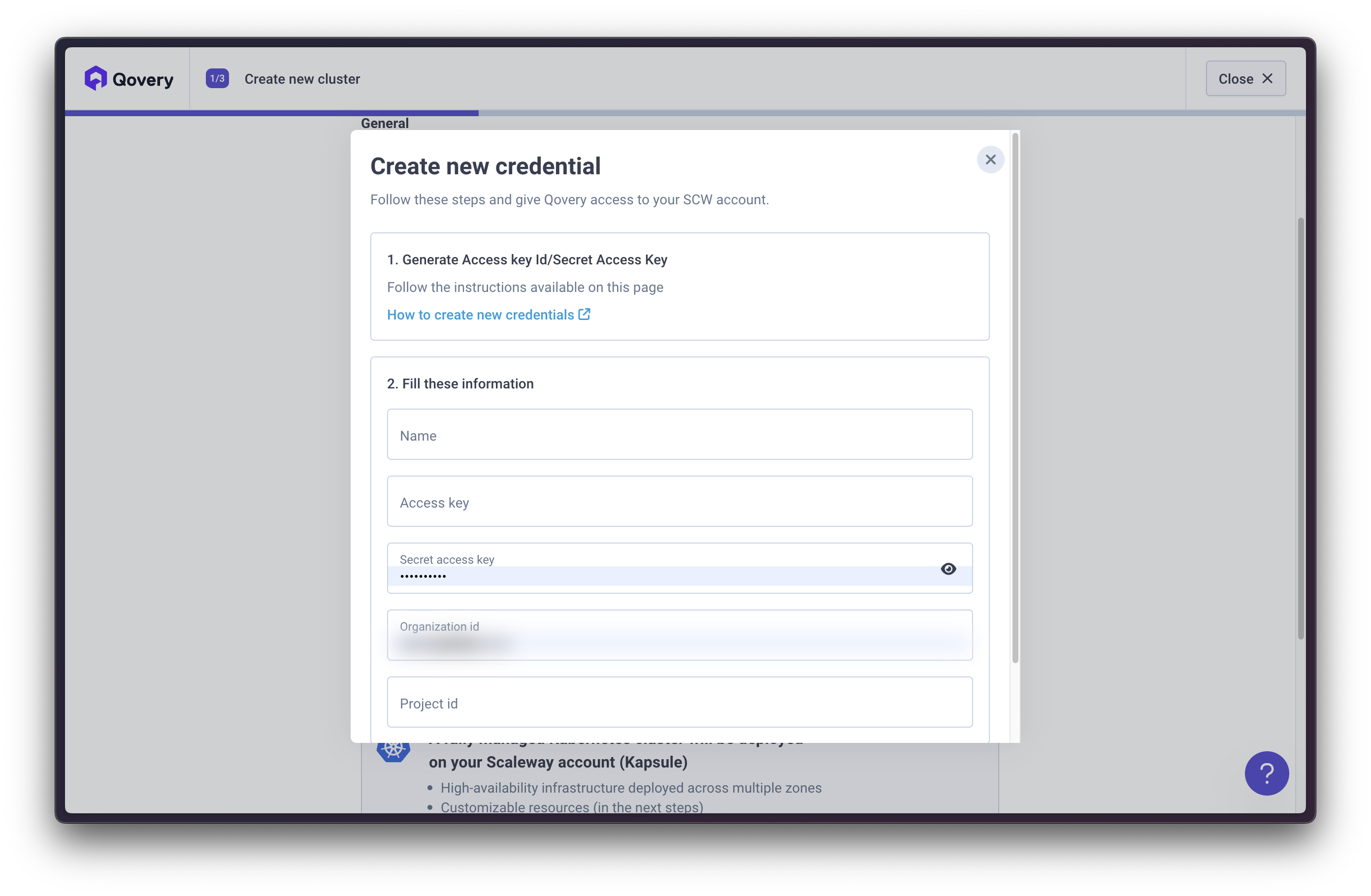Overview
Qovery simplifies Scaleway Kapsule management by:- Automating Kapsule cluster creation and configuration
- Managing networking, load balancers, and DNS
- Providing built-in monitoring and logging
- Handling rolling updates and scaling
- Securing your infrastructure with best practices
Fully Managed
EU Data Sovereignty
Cost Effective
GDPR Compliant
Prerequisites
Before you begin, ensure you have:Why Choose Scaleway?
European Data Sovereignty
European Data Sovereignty
- All data centers located in Europe (Paris, Amsterdam, Warsaw)
- GDPR compliant by design
- No data transfer outside EU
- Sovereignty for sensitive workloads
Cost-Effective
Cost-Effective
- Free Kubernetes control plane (mutualized option)
- Transparent, predictable pricing
- No egress fees within regions
Simplified Infrastructure
Simplified Infrastructure
- Easy-to-use console and APIs
- Fast provisioning times
- Good performance-to-price ratio
- European-based support team
Step 1: Create Scaleway Credentials
Qovery needs API credentials to manage resources in your Scaleway account. We use a secure API key approach with granular permissions.Generate API Key
Access IAM Console
- Log into Scaleway Console
- Click your profile/organization name in the top-right
-
Select Identity and Access Management (IAM)

Create Application
- Navigate to Applications tab
- Click + Create application
- Name it:
qovery-manageror similar - Description: “Qovery cluster management”
- Click Create application
Generate API Key
- Click on your newly created application
- Go to API keys tab
- Click + Generate API key
- Description: “Qovery cluster access”
- Select Object Storage preferred Project (your main project)
- Click Generate API key
- Access key ID:
SCWxxxxxxxxxxxxxxxxx - Secret access key:
xxxxxxxx-xxxx-xxxx-xxxx-xxxxxxxxxxxx
Configure Permissions
- Go to Policies tab in IAM
- Click + Create policy
- Name it:
qovery-permissions - Click Add rule for each of these permission sets:
- ✅ Containers - Full access (for Kapsule management)
- ✅ Network Services - Full access (for VPC, Load Balancers)
- ✅ Compute - Full access (for instances)
- ✅ Storage - Full access (for persistent volumes)
- ✅ VPC - Full access (for networking)
- Under Principal, attach this policy to your application
- Click Create policy
Gather Required IDs
- Go to Organization Settings
- Copy the Organization ID (format:
xxxxxxxx-xxxx-xxxx-xxxx-xxxxxxxxxxxx)
- Go to your Project Dashboard
- Click Project settings
- Copy the Project ID (format:
xxxxxxxx-xxxx-xxxx-xxxx-xxxxxxxxxxxx)
Add Credentials to Qovery
Start Cluster Creation
- Go to Qovery Console
- Click Clusters in the left sidebar
- Click Create Cluster
- Select Scaleway as the cloud provider
Enter Credentials
- Access Key ID: Your Scaleway access key
- Secret Access Key: Your Scaleway secret key
- Organization ID: Your Scaleway organization ID
- Project ID: Your Scaleway project ID

Verify Connection
/snippets/scaleway-credentials.mdx. Update snippet first, then copy to all usage locations.Step 2: Configure Your Cluster
Now configure your Kapsule cluster settings in the Qovery console.Basic Configuration
Cluster Name
production-kapsulestaging-scalewaydev-kapsule-paris
Select Region
fr-par:- Availability Zones:
fr-par-1,fr-par-2,fr-par-3 - Main Scaleway hub with most services
- Lowest latency for Western Europe
- Multiple data centers for redundancy
nl-ams:- Availability Zones:
nl-ams-1,nl-ams-2,nl-ams-3 - Optimal for Northern Europe
- Good connectivity to UK and Scandinavia
- Growing availability zone coverage
pl-waw:- Availability Zones:
pl-waw-1,pl-waw-2,pl-waw-3 - Optimal for Eastern Europe
- Central European location
- Good latency to Germany, Austria, Czech Republic
- Paris: Most mature, largest service catalog
- Amsterdam: Northern Europe, strong connectivity
- Warsaw: Eastern Europe, competitive pricing
Attach Credentials
Node Pool Configuration
Configure the instance types for your Kapsule node pools:Instance Type Recommendations
Instance Type Recommendations
DEV1-M(2 vCPU, 3 GB RAM)DEV1-L(3 vCPU, 4 GB RAM)DEV1-XL(4 vCPU, 6 GB RAM)
GP1-XS(4 vCPU, 16 GB RAM)GP1-S(8 vCPU, 32 GB RAM)GP1-M(16 vCPU, 64 GB RAM)GP1-L(32 vCPU, 128 GB RAM)
COPARM1-2C-8G(2 vCPU, 8 GB RAM) - Budget-friendlyCOPARM1-4C-16G(4 vCPU, 16 GB RAM) - Good balanceCOPARM1-8C-32G(8 vCPU, 32 GB RAM) - Higher capacity
COPARM1-2C-8G(2 vCPU ARM, 8 GB RAM) - Lower costCOPARM1-4C-16G(4 vCPU ARM, 16 GB RAM) - Great valueCOPARM1-8C-32G(8 vCPU ARM, 32 GB RAM) - Best price/performance
Networking Configuration
Qovery automatically configures Scaleway networking: What’s Created:- Private Network (VPC) with custom CIDR
- Load Balancer for ingress traffic
- Public Gateway for NAT (outbound internet)
- Security Groups for firewall rules
- Automatic DNS configuration
Advanced Networking Options
Advanced Networking Options
Control Plane Options
Control Plane Tiers
Control Plane Tiers
- Shared Kubernetes control plane
- No additional cost
- Suitable for development, staging, and production
- 99.9% SLA
- Dedicated control plane resources
- Higher API rate limits
- Better performance under heavy load
- 30-day minimum commitment
Step 3: Deploy Your Cluster
Review Configuration
- Cluster name
- Scaleway project
- Region and availability zones
- Instance types
- Control plane tier
- Networking options
Create and Deploy
Monitor Progress
- 0-5 min: Creating Private Network and security groups
- 5-10 min: Provisioning Kapsule control plane
- 10-15 min: Creating node pool and instances
- 15-20 min: Installing Qovery components (ingress, monitoring, etc.)
- 🟡 Creating: Infrastructure provisioning in progress
- 🟢 Running: Cluster is ready to use
- 🔴 Error: Check logs for troubleshooting
Verify Installation
What Gets Created
Qovery automatically provisions these Scaleway resources:Core Infrastructure
Core Infrastructure
- Kapsule Cluster: Managed Kubernetes cluster
- Private Network: Isolated VPC for your cluster
- Control Plane: Mutualized or dedicated (your choice)
- Node Pool: Auto-scaling group of instances
- Security Groups: Firewall rules for traffic control
- Public Gateway: NAT for outbound internet access
Networking
Networking
- Load Balancer: Layer 4/7 load balancing for ingress
- Public IPs: Flexible IP addresses for services
- DNS: Automatic domain management
- Private IPs: Internal cluster communication
Compute
Compute
- Instances: DEV1, GP1, or Cost-Optimized instances
- Block Storage: SSD volumes for persistent data
- Auto-scaling: Cluster autoscaler for node provisioning
- Multi-AZ: Nodes spread across availability zones
Qovery Components
Qovery Components
- NGINX Ingress Controller: HTTP/HTTPS routing
- Cert-Manager: Automatic SSL/TLS certificates
- Qovery Agent: Cluster management and monitoring
- Metrics Server: Resource usage metrics
- DNS Management: Automatic domain configuration
Post-Installation Steps
Once your cluster is running:Deploy Your First Application
Configure Custom Domain
Set Up Monitoring
Configure Backups
Troubleshooting
Credential Creation Failed
Credential Creation Failed
- Verify all required permissions are attached to your API key via IAM policy
- Check that the API key is active (not expired or revoked)
- Ensure you copied the full access key and secret key correctly
- Verify the Organization ID and Project ID match your Scaleway account
- Make sure your Scaleway project has billing enabled
Cluster Creation Stuck
Cluster Creation Stuck
- Check Scaleway quotas for your project (instances, IPs, block volumes)
- Verify the selected region has instance availability
- Check Scaleway Status Page for outages
- Verify your billing is up to date
- Contact Qovery support if issue persists
Insufficient Quota
Insufficient Quota
- Check your quotas in Scaleway Console → Organization Settings → Quotas
- Request quota increase through Scaleway support
- Try a different availability zone within the same region
- Choose smaller or different instance types
- Clean up unused resources
- Compute instances per zone
- Total vCPUs per organization
- Flexible IPs per project
- Block Storage volumes
- Load Balancers per region
Network Configuration Issues
Network Configuration Issues
- Verify Public Gateway is properly configured
- Check Security Group rules allow outbound traffic
- Ensure Private Network routes are configured
- Verify DNS resolution:
kubectl run -it debug --image=nicolaka/netshoot --rm - Check load balancer health checks are passing
Node Provisioning Failures
Node Provisioning Failures
- Check instance type availability in your region/AZ
- Verify Security Group allows Kapsule control plane communication
- Ensure Private Network is properly configured
- Check instance startup logs in Scaleway console
- Try a different instance type or availability zone
Advanced Configuration
Private Network Routes
Connect your Kapsule cluster to existing Scaleway resources:- Navigate to Private Networks in Scaleway Console
- Attach your existing Private Network to the Kapsule cluster
- Configure routes between networks
- Update Security Groups to allow traffic
- Test connectivity from pods
Using Existing Private Network
Deploy Qovery into your own Private Network:ARM Workloads
Take advantage of ARM instances for better price-to-performance:- Use ARM-compatible container images (most official images support both)
- Add node selector to deployments:
- Test ARM compatibility in staging before production
- Mix ARM and x86 nodes using node selectors for different workloads
Multi-Availability Zone
Increase reliability with multi-AZ deployment:- Configure node pools across multiple AZs
- Use pod anti-affinity to spread replicas
- Configure topology spread constraints
- Test failover scenarios
- Monitor cross-AZ traffic costs
Best Practices
Use ARM Instances
Start with Free Control Plane
Enable Autoscaling
Multi-AZ Deployment
Monitor Costs
Regular Backups
Next Steps
Deploy Your First App
Configure RBAC
Set Up CI/CD
Monitor Your Cluster
Additional Resources
- Scaleway Kapsule Documentation
- Scaleway Pricing Calculator
- Scaleway Status Page
- Qovery Status Page
- Qovery Community Forum - Updates and announcements from the Qovery team

